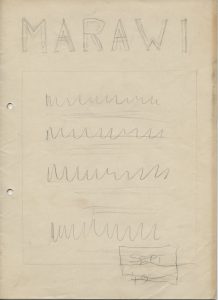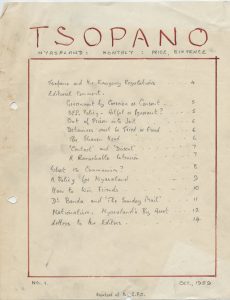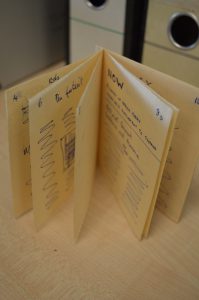The Criminal Investigation Department demanded to see the first issue of Tsopano before it went to print and though the printers refused on principal, the intrusion scared them off the job. In an attempt to rectify the issue, Mackay demanded that the Ministry of Justice state whether there had been any particular reason for such an intrusion or whether the inspection had been routine. By the time this telegram had been received, the original printers were unable to resume the project, leaving Tsopano to find new printers to work with. These new printers had no scruples about showing Tsopano copy to the police whenever they were asked and Tsopano simply learned to work with it, frustrated by the continued interference but confident that it was doing its best to remain within the bounds of the Emergency Regulations.
Page 2 of 2
Whenever Peter Mackay refers to his ‘career’ in his personal papers, he is referring to his work as a journalist. Whatever else he may have accomplished in Africa we might have to describe as his extra curriculars or his passions, maybe more of a lifestyle choice than anything.
From corresponding on Rhodesian Farmer in the late 40’s and early 50’s, Mackay went on to contribute to many local, national and international journals and newspapers and he had an editorial hand in a number of the same. Having said that, I consider Tsopano to be Mackay’s first brainchild. Perhaps it’s because he kept production files for each issue which are crammed with articles edited both for reasons of space and reasons of prudent censorship, interviews, correspondence and administration for the day to day running of a magazine. These files are also contained in the archive and they illuminate the workings of editorship so brilliantly that I began to feel like Tsopano was the crowning glory of all Mackay’s journalistic endeavours. This may or may not be true, but he certainly took great pains to preserve everything to do with the production of the magazine – and created his own notes on the material 35 years after the fact.
“My own interest in a publishing venture in Nyasaland actually began last year when it seemed clear that something was needed to counteract the one-sidedness of press coverage in and about Nyasaland… But whereas before – and always – my thoughts were directed towards trying to condition the attitudes of people of my own race, I now began to think in terms of something which would genuinely help to articulate the little-known and certainly misunderstood cause of African nationalism.”
Personal correspondence, November 1959
So what was Tsopano? Tsopano was an anti-Federation magazine published from 1959-1961 by Mackay originally in Salisbury, Southern Rhodesia for Nyasas in Nyasaland. It ran for 13 issues (all of which are contained in the archive). It was published entirely in English, though Mackay expressed the hope that it might eventually appear in Chinyanja too, because to further the cause of the magazine – which was to present as unbiased an account of African feeling within Nyasaland as possible – Mackay wanted influential English-speakers to be able to easily access the information therein. Indeed, he counted Harold Macmillan as one of his readers among many other high ranking and influential English speakers.
Tsopano sought to inform Nyasas on key government initiatives such as the Devlin Report (1959) and the Monckton Commission (1960), enable constructive criticism of the current political regime and discuss hopes for the future of Nyasaland – no mean feat when the colonial Government had declared a State of Emergency in March 1959, imposing Emergency Regulations which effectively acted as several modes of censorship.
Whilst the magazine was sympathetic to the views of the Malawi Congress Party – how could it not be when they were at the heart of the anti-Federation movement? – and wrote on its members and their activities often, it’s overriding aim was to “provide a true and genuine medium for the expression of African opinion in Nyasaland”. As such, letters to the editor that expressed anger and opposition to the main tone of the periodical were also published from time to time (though it has to be said that the vast majority of correspondence kept in the production files are letters of admiration for the work Tsopano was doing and whole-hearted support for Kamuzu Banda, the leader of the MCP). And Mackay seems to have been sensible of the accusations that might be made of such a magazine, writing in a letter early on in the planning process that Tsopano “does not have among its objects the role of being his [Banda’s] mouthpiece (though its contents will undoubtedly be sympathetic to his views insofar as these are closely identified with ‘expression of African opinion’)…”

This must be a very early doodle of what the magazine was to look like as ‘Marawi’ was discounted as a possible name early on in proceedings.
Careful consideration went into the naming of Tsopano. Mackay tells us in We Have Tomorrow that they had originally thought to use the Chichewa word ‘marawi’ but Kamuzu Banda had asserted that he had different plans for such a name. ‘Marawi’ which literally translates as ‘flames’ became adopted by the Malawi Congress Party – the political party that arose from the ashes of the banned Nyasaland African Congress party in the aftermath of Operation Sunrise (1959) and the symbolism of the phoenix rising from the ashes was deliberately evoked in terms of the party and of the country itself.
So Mackay and his friends were back to the drawing board for names for their periodical. In a letter to his friend and frequent contributor to Tsopano, Jimmy Skinner, Mackay suggested a few Chichewa words chosen for their directness of meaning. ‘Tsopano’, the Chichewa for ‘now’ seems like an afterthought in this discussion but something about it must have appealed to Jimmy because there are no extant mock-ups of any names other than Marawi and Tsopano.

Cover mock-up for Tsopano issue 1
Mackay explains in his book We Have Tomorrow that Tsopano’s overall presentation was intended “to match its serious purpose without being ponderous” and it’s true that there isn’t much that’s visually enticing within the publication. The only photos ever produced are of the Malawi Congress Party conference in Nkhota Kota, 1959 which are Mackay’s own and are also contained in the archive. Illustrations are also few and far between, reserved for key members of the MCP. However, Peter Mackay’s production files are rife with more artistic contributions to the magazine that never make it to print: poems, songs, moralistic tales (my favourite of which is entitled ‘Story of a Wild Pig’) are all sent in by readers keen to voice their frustrations and their hopes but in a more artistic manner. In one response to such a contribution, recorded in the production files, Mackay explains that while space is so limited the editors of Tsopano do not feel they can justify granting inches to items that do not deal directly with political issues.
Despite the above, I enjoy noticing that Mackay couldn’t help himself. The subject matter and its representation might be weighty and thought-provoking but the look of Tsopano as a magazine is bright and cheerful – maybe intended to represent the catharsis and optimism Mackay hoped the magazine and its subject matter would inspire. I like to think of him choosing what lurid colour the next cover would be – an imagining helped along by a comment he made in a letter describing his search for a green that was ‘suitably bilious’ for issue 4. Not only this but in the last issue of Tsopano printed as 1961 dawned in Nyasaland, the year when the Malawi Congress Party would finally win the election and set the wheels of change in motion, Mackay finally printed a poem that had been sent in to Tsopano HQ entitled ‘Thought for the New Year’.

The full run: from the bilious green issue 4 to the silver and gold issues 11 and 12
Tsopano tried to toe the line that Nyasaland’s Emergency Regulations instilled, struggling always to avoid condemnation from the government, regretting the lack of wholly open free speech that they could afford their contributors but always allowing that Tsopano, a much needed vent for the people of Nyasaland, with limitations was ‘better than no Tsopano at all’. Because of this, the study of this periodical and its corresponding production files is also an interesting foray into a world of censorship and defiance of that censorship. From the very first issue Mackay strives to advise on how best to do this – issuing a statement laying out the restrictions that Tsopano faces in no uncertain terms and suggesting constructive criticism rather than open hostility as being the best way of expressing ones views without contravening the rules in place. Even so, some of the editing of letters and articles in the production files makes for incredibly interesting viewing: in and amongst the grammatical corrections and standard truncating of long text are the sentences and paragraphs mostly likely crossed out because they were too bold or passionate to be printed.
“I am still not at all happy at the way the contents suffer from the legal paring they have to undergo.”
Personal correspondence, November 1959
The road to publishing such a series as Tsopano was not smooth. CID intrusion at the initial stages of printing issue 1 forced the original printers to decline to work with Tsopano and ensured that the ensuing printers were kept in the government’s pocket and allowed regular inspection of the copy. Indeed, Mackay’s first production file notes that some of his papers had been taken away without his knowledge, examined by members of the British South Africa Police and returned with their signature – a forceful reminder of why the magazine strove to keep its criticism constructive.

‘Stamp’ of the British South Africa Police which Mackay could not account for when drawing up notes for his production files 35 years on
Though there had always been plans to give control of Tsopano over to Malawis once the MCP were in a better position to oversee its publication and, indeed, Mackay sometimes referred to Tsopano as having been subsumed by Malawi News in correspondence to his friends and acquaintances in the 60’s, Tsopano ceased suddenly some way through preparations for issue 14, perhaps due to a lack of funds foreshadowed in Issue 13 in a statement made about Government pressure restricting revenue from advertising.
But though Mackay may have felt that the nature of Tsopano demanded that he only held control of it temporarily while those who ought to have control were imprisoned or otherwise oppressed, his thirst for action and love for his profession dictated that he start up another magazine – Chapupu II – just over a year after Tsopano ceased business.

Mock-up for the unpublished issue 14

Letters of introduction kept by Mackay and a note of people to whom introductions were sent by the Queen’s personal secretary – on Buckingham Palace notepaper!
I had intended a different first post for this blog, one that started at the beginning of my cataloguing and would proceed as I did – that was until I stumbled across the letters of introduction written by friends of Peter Mackay on the occasion of his emigrating to Southern Rhodesia in 1948. Then I suddenly thought that perhaps I should introduce him too.
Whilst his youth speaks to a certain determination and propensity for hard work that Mackay would later devote to his political interests – he was head boy at Stowe School and the youngest soldier to be made Captain in the Brigade of Scots Guards – and his adult life was one of activism and philanthropism, I wanted to start with something less deterministic and perhaps more personal.
Over the coming weeks, the material in the collection will highlight the very rich involvement in the liberation movements of southern Africa of a remarkable man. But first, I’m going to focus on a couple of gems I’ve unearthed that tell of the everyday Peter Mackay who kept two beautiful bull mastiffs, whose hero was Dr. Livingstone and who, no matter the political crisis, always managed to write home to his mother. The joy of this archive is that you get to learn about it all.
The earliest surviving information on Mackay’s emigration we have are some meticulous accounts of his journey – vivid and leisurely accounts that he wrote to his mother and practical information that was passed around the passengers on the plane concerning their flight.

Telegram home 1949 – ‘Cogitating deeply, writing soon’. I must remember to use that excuse…
From this moment on, Mackay wrote regularly to his family but none more so than his mother, whose replies are also contained within the personal papers files in the archive. His extensive correspondence provides a unique insight into his responses to the world in which he found himself and the reactions he had to it that would define his actions.
When Mackay moved to Southern Rhodesia in 1948, it was with an idea to take up tobacco farming. How he fell into journalism instead isn’t entirely clear, though the links between his intended profession and Rhodesian Farmer, the first journal he worked for, are apparent. The most obvious nod we have in Mackay’s own papers of this other life he might have lived are two newspaper cuttings that he kept detailing the drought that affected tobacco and maize farmers in 1951. A part of me wonders why he kept these newscuttings – was it his evidence that toboacco farming would never have worked out for him anyway?

Articles from The Bulawayo Chronicle and The Sunday Mail, March 1951
As I made a start on this archive, I was often in awe of Peter Mackay because of his intense involvement in the causes he believed in and so when I found some common ground between us in his archive, it leapt out at me: Peter Mackay was a dog man. In 1954, Mackay’s bull mastiffs Salima and Sir Accolon Pendragon (Sally and Nacky to their friends) had puppies and he kept all of the resultant media coverage one would hope that seven adorable puppies might inspire.


A Melee of Mastiffs – The Rhodesia Herald, June 29th 1959
In addition to this – and this is my favourite thing that I’ve found in Mackay’s personal papers – when Mackay returned to the UK for Christmas later in 1954, leaving Nacky and Sally with some friends, such was the bond between a man and his dog that Nacky wrote Mackay letters informing him of the antics of the humans and the latest developments with his many ladyfriends.
“Met a friend and discussed high politics – we sounded very learned and looked it as well – I wonder what he was talking about?”
Sir Accolon Pendragon
‘late of other places and now of Marlborough in Southern Rhodesia’
I always find it interesting to know the kinds of things that inspire remarkable people and so now to Peter Mackay’s own hero, Dr. Livingstone. Livingstone crops up in the Mackay archive from time to time in many forms – a postcard to Mackay’s mother of Victoria Falls or a letter to National Geographic suggesting that they tie in their coverage of Queen Elizabeth’s inaugurating of the Kariba hydro-electric project to the upcoming centenary of Livingstone’s expedition around the area. But no-where more so than in his own writing where he quotes passages from Expedition to the Zambezi and recounts stories that have already provided me, and I suspect will continue to do so as I delve deeper into the archive, with a beautiful context for items that I thought were simply incidental.
“The biggest, the flagship… was the m.v. Ilala II. The first Ilala had been built on the Thames at Tilbury and commissioned in 1875. It had been named after the place where Livingstone died and brought to the Lake of Stars [Lake Nyasa] in a journey epic even for a century of epic journeys.”
We Have Tomorrow

From the Voyage of the Ilala series, 1958
When my preliminary dig through Mackay’s own photographs produced this marvellous series of images entitled ‘Voyage of the Ilala’, I thought nothing further of them then that they were picturesque images from Mackay’s travels. But not only does the above extract show us the link between this boat and Mackay’s hero, suggesting that there was nothing incidental about Mackay being present to take these photos, but his own account of the story of the first Ilala goes to show just how much the ship’s voyage may have mirrored – or even inspired – Mackay’s own desire to provide aid:
“…the Ilala encountered a dhow plying to the eastern shore. On board were captives bound for the slave markets… on the poop [Lieutenant Young of the Ilala] had a two-pound gun, aggressive use of which was forbidden by the mission’s orders. One shot was sent across the bow of the dhow in the traditional and unmistakeable seafarer’s message. The sail came down, the slaver hove to, the captives were freed.”
We Have Tomorrow

Sunset from the Ilala, 1958
Finally, and just as a point of interest, all of Peter Mackay’s photographs, papers and correspondence are so meticulously filed and labelled that, dare I say it, he wouldn’t have made a bad archivist in another life, either.


